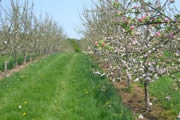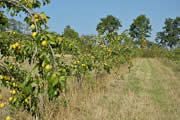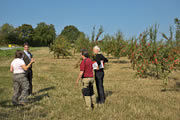


rhs pomona awards
Archive of Cider Pomology Home
| Home |
| WhyOrchard |
| WhatOrchard |
| WhySpecialPlaces |
| ThomasAndrewKnight |
| OrchardWalks |
| NationalOrchardHabitatConference |
The Royal Horticultural Society (RHS) created a new award in 2011 helping mark Herefordshire’s Year in the Orchard.
This first RHS Pomona Award celebrates the achievements of orchard growers across Herefordshire both commercial bush growers and more significantly the traditional standard orchard. 2011 was the pilot for what is hoped to become the National Pomona Awards for orchards. Feedback from 2011 is being given to the RHS who will then decide how to take the awards forward in future years - watch this space and the RHS website for further details during 2012.
Elizabeth Banks, president of the RHS and a patron for Herefordshire Year in the Orchard, said: “Herefordshire’s orchards are many and various and have for centuries been at the forefront of orchard horticulture”.
It began over 200 years ago with the development of revolutionary propagation techniques used by Herefordshire-born Thomas Andrew Knight (who also helped to found the RHS and was its second President from 1811-1838). His ground-breaking ideas were taken forward and developed throughout the 19th century, with great strides being made in husbandry, the development of cider fruit, cider production and new planting techniques by horticultural and cider enthusiasts in Herefordshire and across the world.
“No organisation is better placed to celebrate orchards than the RHS who have for many years worked to conserve and promote the many varieties of British apple grown, however nothing has yet been done to support and celebrate our orchards” said Banks.
As an environment orchards are undervalued by many, yet their importance to the Country’s biodiversity is such that in 2007 they were awarded their own HAP (Habitat Action Plan) status. However, many small and domestic orchards continue to disappear under developer’s chainsaws every year, or are grubbed to make way for pony paddocks.
Traditional orchards are thought to contain 50% of the remaining archaeological evidence for ancient settlements, they support a vast array of flora and fauna, with many species such as Mistletoe Marble moth (previously called the Mistletoe Tortrix) and the wonderfully iridescent Noble Chafer featuring on the ‘red list’ of endangered species, yet orchards have no formal protection.
Pre First World War bush orchards still survive in the county and were used as examples of why Herefordshire’s orchards were unique in Europe when the Common Agricultural Policy was being reviewed several years ago.
“Having done so much to promote our wonderful and varied fruit heritage, now is the time for the RHS to acknowledge and promote our unique orchard heritage before much more is lost. We wish to celebrate them in style returning to the organisations roots by promoting a new award with horticulture at its heart”. Said Elizabeth Banks, RHS President, Herefordian and Patron of The Year in the Orchard.
The Pomona Awards have been developed by the RHS in partnership with Herefordshire’s Year in the Orchard committee. The intention is to celebrate the wonders of our orchard heritage and the genius of Thomas Andrew Knight. For more information on the year and what Thomas Andrew Knight achieved visit the other pages on this website.



Run by Martin & Rachel Soble this organic twenty acre farm has an extensive range of top fruit (apples, pears, plums, gages, cherries, quince, medlar) and soft fruit and vegetables that are sold locally and from the on-site farm shop. The produce is also used by many local restaurants and businesses and in "green box" schemes. The orchard area offers a wide but carefully chosen range of traditional and more modern varieties, carefully planted to maximise the use of the natural landform and ensure that fruit is available throughout the year. Management is well planned to ensure good cropping whilst minimising the staff time required to undertake it. The grass is usually mown just once a year providing a valuable habitat for wildflowers and home for small mammals, invertebrates , reptiles and amphibians. Established in 2004 the enthusiasm and commitment of the Sobles to the project, the farm and orchard really shows in what they have managed to achieve in such a short time.





Archive of Cider Pomology Home